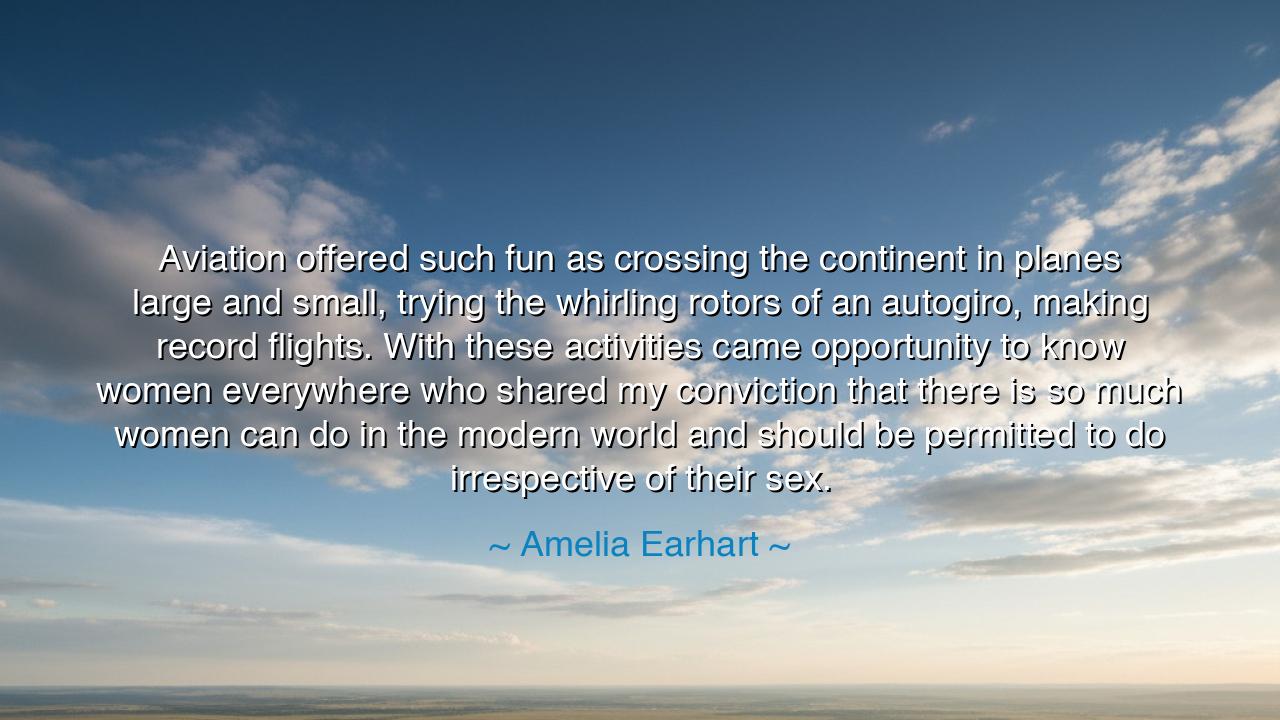
Aviation offered such fun as crossing the continent in planes
Aviation offered such fun as crossing the continent in planes large and small, trying the whirling rotors of an autogiro, making record flights. With these activities came opportunity to know women everywhere who shared my conviction that there is so much women can do in the modern world and should be permitted to do irrespective of their sex.






Amelia Earhart’s words—"Aviation offered such fun as crossing the continent in planes large and small, trying the whirling rotors of an autogiro, making record flights. With these activities came opportunity to know women everywhere who shared my conviction that there is so much women can do in the modern world and should be permitted to do irrespective of their sex"—resound like the hymn of a pioneer who dared to seize the skies. She speaks not only of flight, but of freedom: the boundless promise that when one dares to ascend, the chains of expectation fall away.
The essence of her declaration is that aviation, once the domain of men, became for her and her sisters a symbol of liberation. In the open skies, there were no gates barring women, no traditions heavy enough to weigh down a wing. The cockpit became a sanctuary where courage, skill, and vision mattered more than sex, and where the modern world revealed itself as a place not of limits, but of possibilities.
History itself testifies to this truth. When Earhart crossed the Atlantic alone in 1932, she became the first woman to achieve such a feat. In doing so, she joined the ranks of the great explorers, but more than that, she proved that women could master what had been deemed impossible for them. Like Jeanne d’Arc, who once defied the limits placed upon her in battle, Earhart carried the standard of women into the heavens themselves, showing that courage wears no single face or gender.
Her mention of the autogiro—that strange and wondrous craft of whirling rotors—reminds us that progress comes not by standing still, but by venturing into the unknown. So too with the cause of women: each experiment, each daring attempt, pushes the boundary further. Earhart and her companions believed, with unshaken faith, that the modern world must no longer deny women the right to attempt, to strive, to fail, and to triumph on their own terms.
Let future generations remember: the struggle for equality is not only fought in parliaments and courts, but also in the skies, on seas, and across every frontier where the human spirit dares to go. Amelia Earhart’s words remind us that the wings of women, once unfurled, cannot be folded back. To permit them to soar is to allow the whole world to rise higher.






PTPhu Thien
Earhart’s reflection on her journey highlights not just the excitement of aviation but the broader message of empowerment for women. Her efforts to prove that women can achieve great things regardless of gender were groundbreaking. But are women today still facing the same battles to be recognized equally in professions like aviation, or has society made enough progress to ensure equal opportunities for all?
HTDo Ha Trang
The quote reflects Earhart’s profound belief in gender equality and the limitless potential of women. Her experiences in aviation provided her with the platform to advocate for women’s rights. However, in today’s society, do we fully support women’s ambitions in the same way, or are there still barriers that limit their opportunities in certain professions? How can we honor Earhart’s legacy by fostering more inclusive spaces for women to thrive?
PTduong phuong thuy
Earhart’s words challenge traditional gender roles and emphasize the potential of women in fields where they were once excluded. Aviation was an arena where women like her defied the norms of their time. Are we now seeing the same level of defiance and progress in other traditionally male-dominated fields today, such as STEM, politics, and engineering? How can we continue to push boundaries and create opportunities for women everywhere?
CBcute bede
Amelia Earhart’s statement about the opportunities she found in aviation speaks to the progressive spirit of her time, especially regarding women’s roles in society. Her recognition of women’s potential in aviation and other fields is a powerful reminder of how far we’ve come, but also how much further we need to go. In today’s world, are we still held back by gender expectations, or are we truly embracing equal opportunity across all sectors?